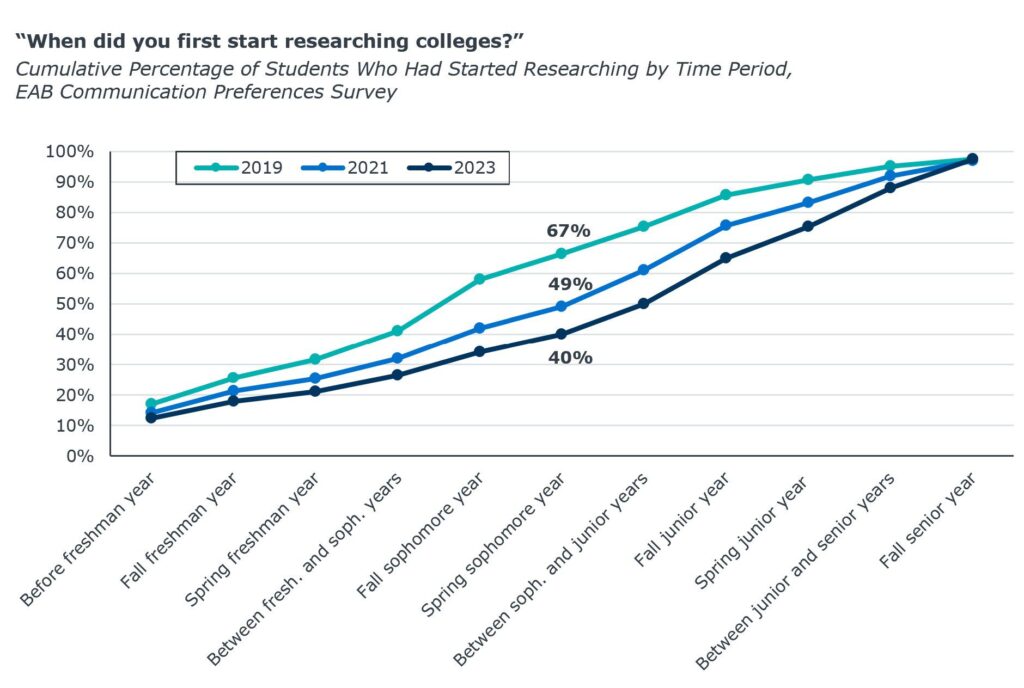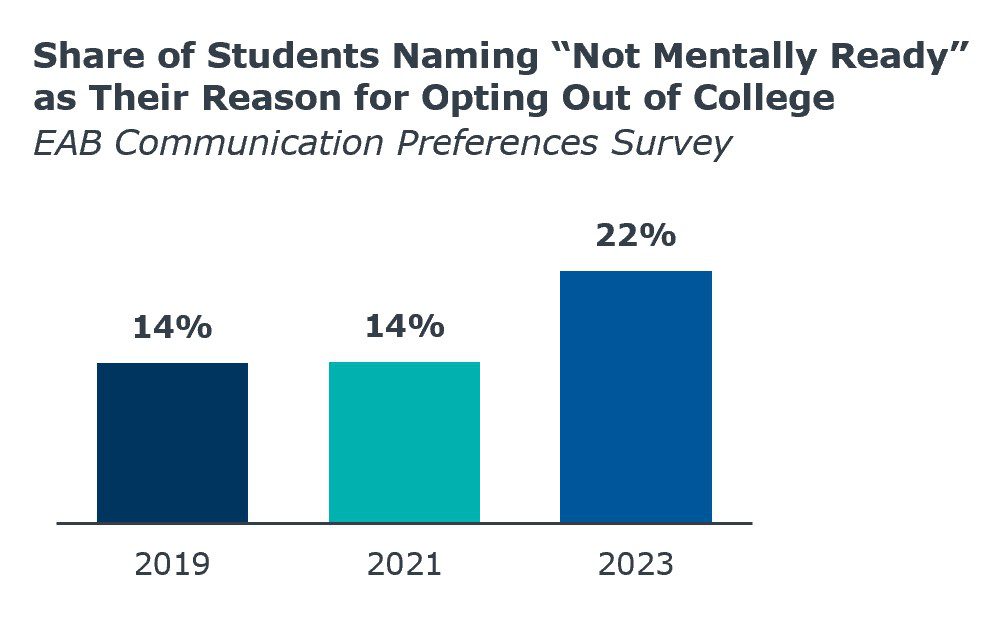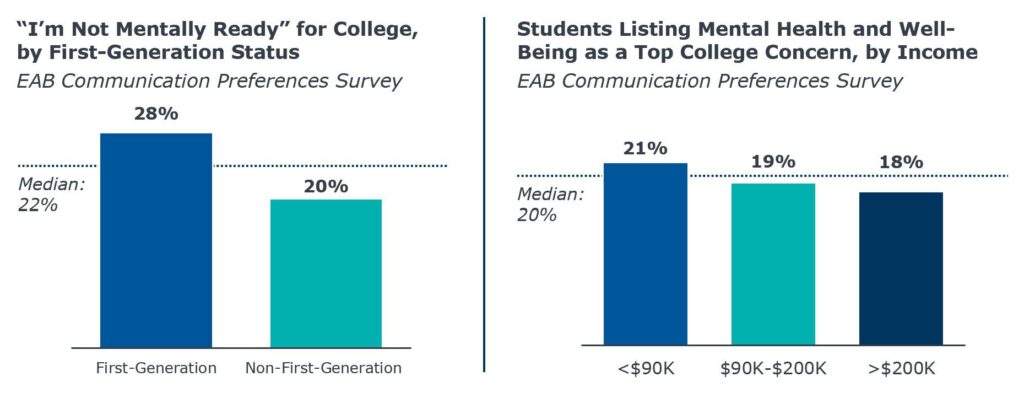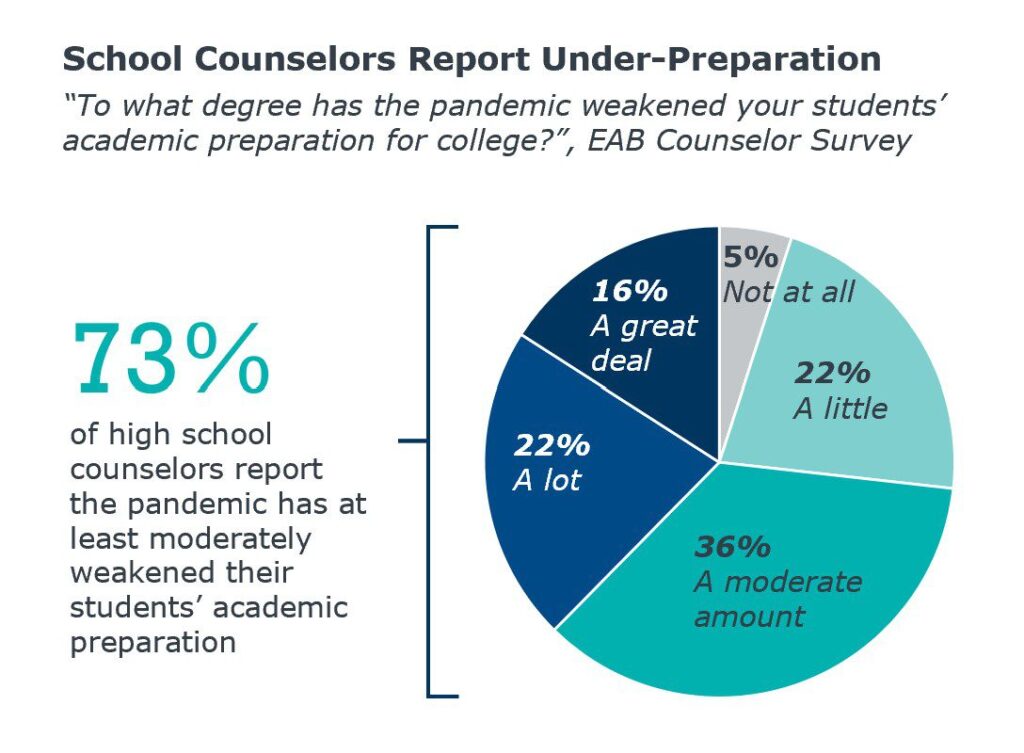Are you prepared to recruit ‘Gen P’?
3 ways the pandemic changed college search behavior from our new survey of 20K+ high school students
July 17, 2023, By Michael Koppenheffer, Vice President, Enroll360 Marketing, Analytics and AI Strategy
When was the last time you saw a teenager willingly answer a phone call?
As the parent of teenagers myself, I can attest that many members of ‘Gen P’—the students whose past few years have been defined by the pandemic and its aftermath—interact with the world very differently than their predecessors.
Our partners are noticing these shifts in behavior as well. A number of VPEMs have shared with me recently that they’re seeing new patterns in prospective student interactions, such as students being markedly less responsive to counselor phone calls. But are these anecdotal observations or a real trend?
Fortunately, we now have some hard data to turn to, thanks to the latest edition of EAB’s Student Communication Preferences Survey. For more than a decade, we’ve asked high school students about their college search preferences and behaviors. And thanks to the survey’s longevity and expansive reach (over 20,000 students this year!), it’s an ideal tool for determining whether an observed student behavior represents a true phenomenon.
Here are three key insights for enrollment leaders about recruiting this new generation of students.
Insight #1: Timing of student search behaviors is shifting.
One of the biggest changes we observed in college search behavior is related to timing: students aren’t completing steps in their enrollment journey according to the “traditional” timeline. For example, today’s students are beginning their college research later than their predecessors did. As illustrated in the chart below, 67% of participants in our 2019 survey had started researching colleges by the end of their sophomore year. In 2023, only 40% of students had started researching by that point.

It makes sense that the pandemic played a role in this trend: high school counselors reported that many of their students were less focused on college research during the pandemic, as they had less access to school resources and deprioritized college planning amid the stressors of the pandemic. And while we’re currently observing this trend among students who were in high school during the pandemic, it remains to be seen whether it will continue among students who were in middle school during the pandemic.
Enrollment leaders have also reported another shift in the timing of student search behaviors: students are increasingly delaying visits from the traditional spring of junior year or fall senior year timing to spring of senior year, after they’ve been admitted. One enrollment leader I spoke with theorized that, with students applying to a large number of schools, they’re waiting to see where they’re admitted and what their aid awards are before committing to visiting schools.
Key recommendations for enrollment leaders
- Use a Flexible, Responsive Approach to Marketing
As the timing of students’ search processes becomes less predictable, responsive and multichannel marketing can help you ensure that your outreach content, timing, and channels engage students, even as preferences vary or shift. - Reinforce the Value of Your Programs with Early and Persistent Affordability Messaging
While value messaging has long been a central area of focus for colleges, it’s now more important than ever to ensure that you have a strong, multichannel communication strategy for both students and parents. Be sure to highlight features that most interest families, including information on job placement, internships, and career services.
Insight #2: Mental health concerns are shaping Gen P’s college search.
As we’ve all likely seen or at least heard, the pandemic took a big toll on teen mental health nationally. During that time, teenagers were largely cut off from seeing friends, attending school, and participating in extra-curricular activities in person, with social media and other screen time often filling the void—all of which exacerbated mental health challenges. So what are the implications of this worrisome trend for college search?
Our survey data indicates that mental health now plays a more significant role than it did previously in a student’s decision not to pursue college immediately after high school. Of students who are not planning to attend college, “I’m not mentally ready” was a top reason they named for opting out even before the pandemic. However, the percentage of students saying “I’m not mentally ready” sharply increased in 2023, likely reflecting the pandemic’s high mental health toll.
-
36%
of parents of teen girls reported their child showed new or worsening symptoms of anxiety in 2021.

We also found that mental health concerns related to college were more prevalent among first-generation students and low-income students than their counterparts, as the graphs below illustrate.

Download the full report on recruiting ‘Gen P’
Insight #3: Students are academically underprepared.
In addition to understanding how changes in social and emotional well-being impacted college search behaviors, we were also eager to understand the impact of pandemic learning loss. While academic proficiency levels in the United States have been low for many years, pandemic disruptions in classroom learning had a major impact. And while students lost ground academically across demographic groups, historically underserved students were especially likely to experience losses in academic achievement because they were less likely to receive in-person instruction during the pandemic.
-
5-point
Drop in average scores during the pandemic—the largest ever recorded, according to the National Assessment of Educational Progress (NAEP), a large-scale assessment of K-12 student progress.
We saw these trends reflected in a variety of EAB survey data. In our 2023 survey of high school counselors, 73% of high school counselors reported that the pandemic had at least moderately weakened their students’ academic preparation. We also found that, as students consider their college education, many are understandably nervous about their academic preparedness: twenty-six percent of students surveyed by EAB selected “whether I’ll be successful in college” as a top concern about college, behind only affordability and cost considerations.

While the data points above illustrate the immediate effects of pandemic learning loss on today’s high school students, it’s important to bear in mind that we’re likely to experience the pandemic’s continued—and evolving—effects among high school students for years to come. As shown below, learning loss as early as third grade can have a profound impact on likelihood to graduate from high school and enroll in college.
Students not reading proficiently by third grade are...
75%
Never reach reading proficiency in future grades4x
More likely not to graduate from high school on time54%
Less likely to enroll at a college or university after high school
Key recommendations for enrollment leaders
- Address Families’ Academic Preparedness Concerns in Marketing: Similar to concerns about mental health, ensure your messaging addresses families’ worries about learning loss and academic preparedness.
- Build Strong Relationships with Community-Based Organizations (CBOs): CBOs can be an especially important connecting point between colleges and high-potential under-served students.
So, the verdict is in: in important ways, today’s high school students are behaving differently from their recent predecessors. clear patterns have emerged in Gen P’s behavior, I’d bet we’ll continue to see changes in how students are approaching college search across the coming months. We’ll be watching closely, and as we learn more, we look forward to sharing those updates with you.

More Blogs

The 2026 .edu accessibility mandate is coming—is your site content ready?

The balancing act: How the right mix of branded and non-branded keywords shapes higher ed SEO

Struggling to attract graduate students? Here are four ways to fix it
Great to see you today! What can I do for you?